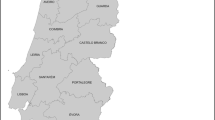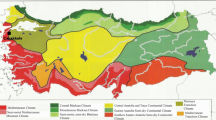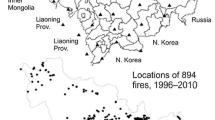Abstract
Forest fires caused by natural forces or human activities are one of the major natural risks in Northeast China. The incidence and spatial distribution of these fires vary over time and across the forested areas in Jilin Province, Northeast China. In this study, the incidence and distribution of 6519 forest fires from 1969 to 2013 in the province were investigated. The results indicated that the spatiotemporal distribution of the burnt forest area and the fire frequency varied significantly by month, year, and region. Fire occurrence displayed notable temporal patterns in the years after forest fire prevention measures were strictly implemented by the provincial government. Generally, forest fires in Jilin occurred in months when stubble and straw were burned and human activities were intense during traditional Chinese festivals. Baishan city, Jilin city, and Yanbian were defined as fire-prone regions for their high fire frequency. Yanbian had the highest frequency, and the fires tended to be large with the highest burned area per fire. Yanbian should thus be listed as the key target area by the fire management agency in Jilin Province for better fire prevention.





Similar content being viewed by others
References
Bergeron Y (1991) The influence of island and mainland lakeshore landscapes on boreal forest fire regimes. Ecology 72:1980–1992
Cardille JA, Ventura SJ, Turner MG (2008) Environmental and social factors influencing wildfires in the Upper Midwest, United States. Ecol Appl 11:111–127
Carvalho JA, Amaral SS, Costa MAM, Neto TGS, Veras CAG, Costa FS, Leeuwen TTV, Filho GCK, Tourigny E, Forti MC (2016) CO2 and CO emission rates from three forest fire controlled experiments in Western Amazonia. Atmos Environ 135:73–83
Clark JS (1990) Fire and climate change during the last 750 Yr in Northwestern Minnesota. Ecol Monogr 60:135–159
Cogbill CV (1985) Dynamics of the boreal forests of the Laurentian Highlands, Canada. Can J For Res 15:252–261
Crutzen PJ, Delany AC, Greenberg J, Haagenson P, Heidt L, Lueb R, Pollock W, Seiler W, Wartburg A, Zimmerman P (1985) Tropospheric chemical composition measurements in Brazil during the dry season. J Atmos Chem 2:233–256
Elia M, Lafortezza R, Tarasco E, Colangelo G, Sanesi G (2012) The spatial and temporal effects of fire on insect abundance in Mediterranean forest ecosystems. For Ecol Manage 263:262–267
Engelmark O, Kullman L, Bergeron Y (1993) Fire and age structure of Scots pine and Norway spruce in northern Sweden during the past 700 years. New Phytol 126:163–168
Gill AM, Allan G (2008) Large fires, fire effects and the fire-regime concept. Int J Wildland Fire 17:688–695
Hessl AE, Mckenzie D, Schellhaas R (2004) Drought and pacific decadal oscillation linked to fire occurrence in the inland Pacific Northwest. Ecol Appl 14:425–442
Heyerdahl EK, Brubaker LB, Agee JK, Heyerdahl EK (2002) Annual and decadal climate forcing of historical fire regimes in the interior Pacific Northwest, USA. Holocene 12:597–604
Heyerdahl EK, Brubaker LB, Agee JK (2008) Spatial controls of historical fire regimes: a multiscale example from the Interior West, USA. Ecology 82:660–678
Hunter ML (1993) Natural fire regimes as spatial models for managing boreal forests. Biol Conserv 65:115–120
Jilin Bureau of Statistics (2014) Jilin statistical yearbooks. China Statistics Press, Beijing
Kandya AK, Kimothi MM, Jadhav RN, Agarwal JP (1998) Application of geographic information system in identification of ‘fire-prone’ areas—a Feasibility study in parts of Junagadh (Gujarat). Indian For 124:531–535
Kitzberger T, Veblen TT, Villalba R (1997) Climatic influences on fire regimes along a rain forest-to-xeric woodland gradient in northern Patagonia, Argentina. J Biogeogr 24:35–47
Larsen CPS (2010) Spatial and temporal variations in boreal forest fire frequency in northern Alberta. J Biogeogr 24:663–673
Malamud BD, Millington JD, Perry GL (2005) Characterizing wildfire regimes in the United States. Proc Natl Acad Sci USA 102:4694–4699
Martínez J, Vega-Garcia C, Chuvieco E (2009) Human-caused wildfire risk rating for prevention planning in Spain. J Environ Manag 90:1241–1252
Minnich R, Chou Y (1997) Wildland fire patch dynamics in the chaparral of Southern California and Northern Baja California. Int J Wildland Fire 7:221–248
Niklasson M, Granström A (2008) Numbers and sizes of fires: long-term spatially explicit fire history in a swedish boreal landscape. Ecology 81:1484–1499
Nunes AN, Lourenço L, Meira ACC (2016) Exploring spatial patterns and drivers of forest fires in Portugal (1980–2014). Sci Total Environ 573:1190–1202
Padilla M, Vegagarcía C (2011) On the comparative importance of fire danger rating indices and their integration with spatial and temporal variables for predicting daily human-caused fire occurrences in Spain. Int J Wildland Fire 20:46–58
Prestemon JP, Butry DT (2005) Time to burn: modeling wildland arson as an autoregressive crime function. Am J Agric Econ 87:756–770
Romero-Calcerrada R, Novillo CJ, Millington JDA, Gomez-Jimenez I (2008) GIS analysis of spatial patterns of human-caused wildfire ignition risk in the SW of Madrid (Central Spain). Landsc Ecol 23:341–354
Russellsmith J, Ryan PG, Durieu R (1997) A LANDSAT MSS-derived fire history of Kakadu National Park, monsoonal northern Australia, 1980–94: seasonal extent, frequency and patchiness. J Appl Ecol 34:748–766
Sanmiguelayanz J, Barbosa P, Schmuck G, Liberta G, Schulte E, Viegas DX (2002) Towards a coherent forest fire information system in Europe: the European Forest Fire Information System (EFFIS). In: Forest fire research and wildland fire safety: proceedings of IV international conference on forest fire research 2002 Wildland Fire Safety Summit, Luso, Coimbra, Portugal, pp 18–23
Stocks BJ, Martell DL (2016) Forest fire management expenditures in Canada: 1970–2013. For Chron 92:298–306
Tuček J, Majlingová A (2009) Forest fire vulnerability analysis. In Bioclimatology and natural hazards. Springer, Dordrecht, pp 219–230
Turner MG, Romme WH (1994) Landscape dynamics in crown fire ecosystems. Landscape Ecol 9:59–77
Ullah MR, Liu XD, Al-Amin M (2013) Spatial-temporal distribution of forest fires and fire weather index calculation from 2000 to 2009 in China. J For Sci 27:240–255
Vazquez A, Moreno J (1998) Patterns of lightning-, and people-caused fires in Peninsular Spain. Int J Wildland Fire 8:103–115
Wei MH, Liu MH, Crutzen PJ (1990) Estimates of annual and regional releases of CO2 and other trace gases to the atmosphere from fires in the tropics, based on the FAO statistics for the period 1975–1980. Springer, Berlin, pp 440–462
Werf GRVD, Randerson JT, Collatz GJ, Giglio L, Kasibhatla PS, Arellano AF, Olsen SC, Kasischke ES (2004) Continental-scale partitioning of fire emissions during the 1997 to 2001 El Nino/La Nina period. Science 303:73–76
Yanbian Bureau of Statistics (2014) Yanbian Statistical Yearbooks. Yanbian People’s Publishing House, Yanbian
Author information
Authors and Affiliations
Corresponding author
Additional information
Project Funding: This research was financially supported by the National Key Research and Development Plan (2017YFD0600106); the National Natural Science Foundation of China under Grant 31470497; Project 2013-007, Jilin Provincial Forestry Department. It is also supported by the Program for New Century Excellent Talents in University (NCET-12-0726).
The online version is available at http://www.springerlink.com.
Corresponding editor: Hu Yanbo.
Rights and permissions
About this article
Cite this article
Liu, Q., Shan, Y., Shu, L. et al. Spatial and temporal distribution of forest fire frequency and forest area burnt in Jilin Province, Northeast China. J. For. Res. 29, 1233–1239 (2018). https://doi.org/10.1007/s11676-018-0605-x
Received:
Accepted:
Published:
Issue Date:
DOI: https://doi.org/10.1007/s11676-018-0605-x




